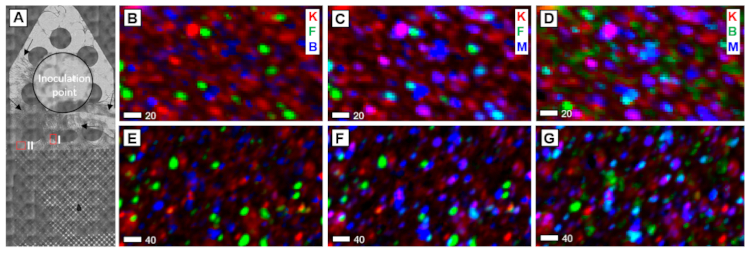Saprotrophic Fungus Weathers Potassium from Minerals in Carbon-Limited Environment
05/05/2023

Potassium X-ray fluorescence (XRF) images reveal growth of fungal hyphae on synthetic soil habitat (SSH) surfaces for 30 days. (A) An optical microscopy image of the SSH micromodel with 30 days of fungal growth. The black circle denotes the edge of the inoculation point. Arrows point to fungal hyphae of varying density across the SSH surface. Red boxes outline regions mapped by XRF. At right, XRF scans show region I (B–D) and region II (E–G) with colors representing kaolinite (K), feldspar (F), biotite (B), and montmorillonite (M). Scale bars are in microns.
[Reprinted from Richardson et al. 2023. DOI: 10.3390/min13050641.]
The Science
Potassium plays an important role in processes that contribute to overall plant health and growth and can mitigate drought effects in many species. Thus, finding sustainable pathways to increase bioavailability in the rhizosphere of this limiting environmental nutrient is critical as climate change continues to alter soil processes.
Using micro-X-ray fluorescence (XRF) imaging combined with micro-X-ray absorption near edge structure (XANES) spectroscopy, researchers found that under nutrient-limited conditions the saprotrophic fungus Fusarium sp. DS 682 can indirectly weather potassium-rich minerals—specifically potassium feldspar and biotite—into tens-of-micrometer-scale clay particles that coat the mineral grains within 30 days. The distribution of clay coatings was associated with proximity to a carbon source, with more clay forming on potassium feldspar close to a carbon source but more clay forming on biotite at greater distances from the carbon source.
The Impact
The observed mineral weathering patterns by fungal hyphae likely result from changing fungal metabolism with distance to a single carbon source. Distance affects the production of fungal exuded organic acids and drives surface mineral alteration and subsequently secondary mineral formation. This study details the transition of potassium from structurally bound, non-bioavailable potassium to readily accessible potassium pools, a key process for increasing local bioavailability of potassium in soils.
The Summary
Researchers at the Environmental Molecular Science Laboratory (EMSL) developed synthetic soil habitats (SSHs) which replicate physical and chemical properties of soil within a reduced-complexity environment. A key aspect of SSHs is their amenability to multimodal imaging approaches.
In this study, soil chemical properties were simulated using a mixture of potassium-rich minerals, such as potassium feldspar and micas, as well as kaolinite clay and quartz. After fungal growth, samples were lyophilized (i.e., freeze-dried) and the hyphae removed from SSH surfaces. The SSHs were cleaned with chloroform to remove any potassium sorbed to organic compounds on the SSH surface. This enabled the surface chemistry of the minerals to be determined without interfering signal from any leftover organics. The SSHs were then analyzed at the Stanford Synchrotron Radiation Lightsource (SSRL) X-ray microprobe beamline 14-3, which is well-suited to potassium chemical speciation imaging.
Funding
This research was performed on a project award (10.46936/intm.proj.2021.60094/60001433) from the Environmental Molecular Sciences Laboratory, a DOE Office of Science User Facility sponsored by the Biological and Environmental Research program under Contract No. DE-AC05-76RL01830.
Related Links
References
Richardson, J.A., Anderton, C.R., and A. Bhattacharjee. 2023. “Saprotrophic Fungus Induces Microscale Mineral Weathering to Source Potassium in a Carbon-Limited Environment,” Minerals 13 (5), 641. DOI: 10.3390/min13050641.
